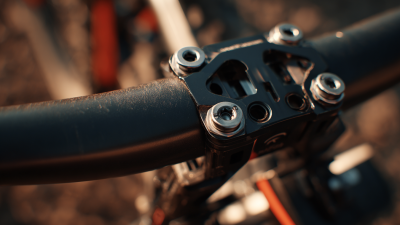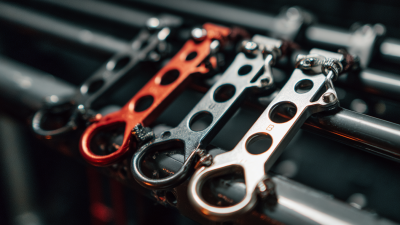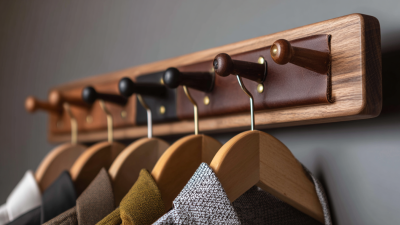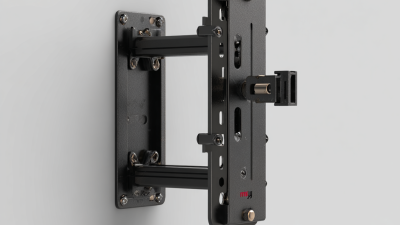The Ultimate Guide to Choosing the Best Mounting Hooks for Your Needs
In the realm of home organization and decor, selecting the right hardware can significantly impact both functionality and aesthetics. Among these essential tools, mounting hooks play a pivotal role, with the global market expected to reach $3.5 billion by 2025, driven by rising consumer demand for effective storage solutions. According to a recent report by MarketWatch, the market for organizational accessories, including mounting hooks, grew by 5.2% annually over the past five years. As homes become increasingly multifunctional, the versatility of mounting hooks—from supporting heavy items like bicycles to displaying decorative pieces—makes them indispensable for homeowners and renters alike. This ultimate guide will equip you with expert tips to choose the best mounting hooks tailored to your specific needs, ensuring durability, safety, and style in every application.

Understanding Different Types of Mounting Hooks for Various Applications
 When selecting mounting hooks, understanding the different types available is essential for making an informed choice tailored to your specific requirements. According to a recent industry report by Grand View Research, the global market for mounting hardware is expected to reach $45.6 billion by 2025, indicating a growing demand for versatile and reliable mounting solutions. Among the various types of mounting hooks, options such as S-hooks, J-hooks, and heavy-duty hooks serve distinct functions and applications.
When selecting mounting hooks, understanding the different types available is essential for making an informed choice tailored to your specific requirements. According to a recent industry report by Grand View Research, the global market for mounting hardware is expected to reach $45.6 billion by 2025, indicating a growing demand for versatile and reliable mounting solutions. Among the various types of mounting hooks, options such as S-hooks, J-hooks, and heavy-duty hooks serve distinct functions and applications.
S-hooks, known for their simplicity and ease of use, are ideal for lightweight applications, particularly in kitchens or workshops for hanging utensils or tools. On the other hand, J-hooks are designed for more substantial items, providing additional security and stability for storage solutions in garages or basements. According to a study by Market Research Future, heavy-duty hooks are projected to account for a significant market share, fueled by the rising demand for heavyweight capacity solutions in both residential and commercial settings. This diversification in mounting hook design underscores the importance of choosing the right type based on the weight and application to ensure safety and effectiveness.
Factors to Consider When Selecting Mounting Hooks for Your Projects
When selecting mounting hooks for your projects, it’s essential to consider several key factors to ensure you choose the right option for your specific needs. First, assess the weight capacity required. Different hooks are designed to hold varying amounts of weight, so knowing the load will help prevent accidents and ensure stability. For heavier items, opt for heavy-duty hooks made from robust materials like steel, whereas lighter decorative items can be supported by thinner, more aesthetically pleasing options.
Another critical factor is the hook's design and intended use. Consider whether you need fixed or adjustable hooks; adjustable hooks offer versatility for different projects, while fixed hooks provide a secure hold for items that do not need to be moved frequently. Additionally, think about the installation method. Some hooks require drilling and wall anchors, while others can be easily mounted using adhesive or nails. Finally, the hook's finish is also important, especially if aesthetics matter for your project. Choose hooks that complement your décor while ensuring durability, as outdoor projects may need rust-resistant coatings for longevity.
The Ultimate Guide to Choosing the Best Mounting Hooks for Your Needs
Comparing Material Durability: Metal vs. Plastic Mounting Hooks
When it comes to selecting mounting hooks, understanding the durability of the materials is paramount. Metal hooks, often made from stainless steel or aluminum, are known for their exceptional strength and longevity. According to a recent industry report by the Home Improvement Research Institute, metal mounting hooks can support up to 50% more weight than their plastic counterparts, making them ideal for heavier items such as tools or large artworks. Additionally, metal resists warping and can withstand extreme temperatures, which is crucial for outdoor applications.
On the other hand, plastic mounting hooks offer their own set of advantages, particularly in terms of weight and cost. A study published by the Plastic Industry Association indicates that modern plastics, like high-density polyethylene (HDPE), can compete with metal in terms of tensile strength yet remain significantly lighter. This makes them easier to install and handle, especially for DIY enthusiasts. However, it’s worth noting that plastic hooks tend to have a lower load-bearing capacity and may degrade faster under UV exposure, which can lead to a decrease in durability over time. Therefore, the choice between metal and plastic mounting hooks ultimately hinges on the specific requirements of your project and the environment in which the hooks will be used.
Installation Tips for Optimal Performance of Your Mounting Hooks
When it comes to installing mounting hooks, proper techniques are essential to achieve optimal performance. Start by selecting the right location for your hooks; ensure it is sturdy and suitable for the items you plan to hang. Ideally, mount your hooks into wall studs rather than drywall alone for maximum support. Use a stud finder to locate these structural elements, ensuring your installation can bear the weight without risk of damage.
Once you've identified the right spot, prepare your tools and materials. A drill, appropriate screws, and level will all be necessary for a successful setup. Mark the spots where the hooks will go, double-checking that they are aligned and evenly spaced. For heavier items, consider using anchors to provide additional stability. Follow the manufacturer's instructions carefully for any specific requirements related to the hooks you've chosen, as this will help you achieve a secure and effective installation that can handle your needs with ease.
The Ultimate Guide to Choosing the Best Mounting Hooks for Your Needs
| Hook Type | Weight Capacity | Material | Ideal Use | Installation Difficulty |
|---|---|---|---|---|
| Heavy Duty Hook | 100 lbs | Steel | Garage, Shed | Medium |
| Wall Mount Hook | 50 lbs | Plastic | Home Organization | Easy |
| Suction Cup Hook | 10 lbs | Rubber | Bathroom, Kitchen | Very Easy |
| Utility Hook | 30 lbs | Aluminum | Garden, Workshop | Medium |
| Hanging Hook | 15 lbs | Plastic | Outdoor Decor | Easy |
Common Mistakes to Avoid When Choosing Mounting Hooks for Your Needs
 When selecting mounting hooks, avoiding common mistakes can significantly enhance both functionality and aesthetics. One frequent oversight is failing to consider the weight capacity of the hooks you choose. Hooks come in various sizes and strength ratings; using an insufficiently robust hook can lead to unfortunate mishaps, such as the item falling and damaging your wall or decor. Always check the specifications to ensure they match the items you intend to hang.
When selecting mounting hooks, avoiding common mistakes can significantly enhance both functionality and aesthetics. One frequent oversight is failing to consider the weight capacity of the hooks you choose. Hooks come in various sizes and strength ratings; using an insufficiently robust hook can lead to unfortunate mishaps, such as the item falling and damaging your wall or decor. Always check the specifications to ensure they match the items you intend to hang.
Another common error is neglecting the compatibility between the hook and the surface it will be mounted on. Some hooks work best on drywall, while others may require sturdy studs for optimal support. This misalignment can lead to instability and dissatisfaction with the final setup. Additionally, measuring your space before purchasing hooks is crucial to ensure they're suitable for the décor and don’t interfere with other elements in the room. By taking the time to avoid these pitfalls, you'll create a secure and stylish display that enhances your living space.
Related Posts
-

Innovative Examples of the Best Mounting Bracket Solutions for Your Needs
-

Ultimate Showdown: 2023's Top 5 Mounting Hooks Compared for Durability and Strength
-

Discovering Top Manufacturers for Best Wall Hangers and Effective Sourcing Solutions
-

Top Industry Standards and Seven Key Reasons to Choose the Best Wall Bracket
-

How to Maximize After-Sales Support While Reducing Repair Costs for the Best Storage Trays
-

The Ultimate Guide to Choosing the Best Adjustable Shelving: Key Insights and Industry Trends
